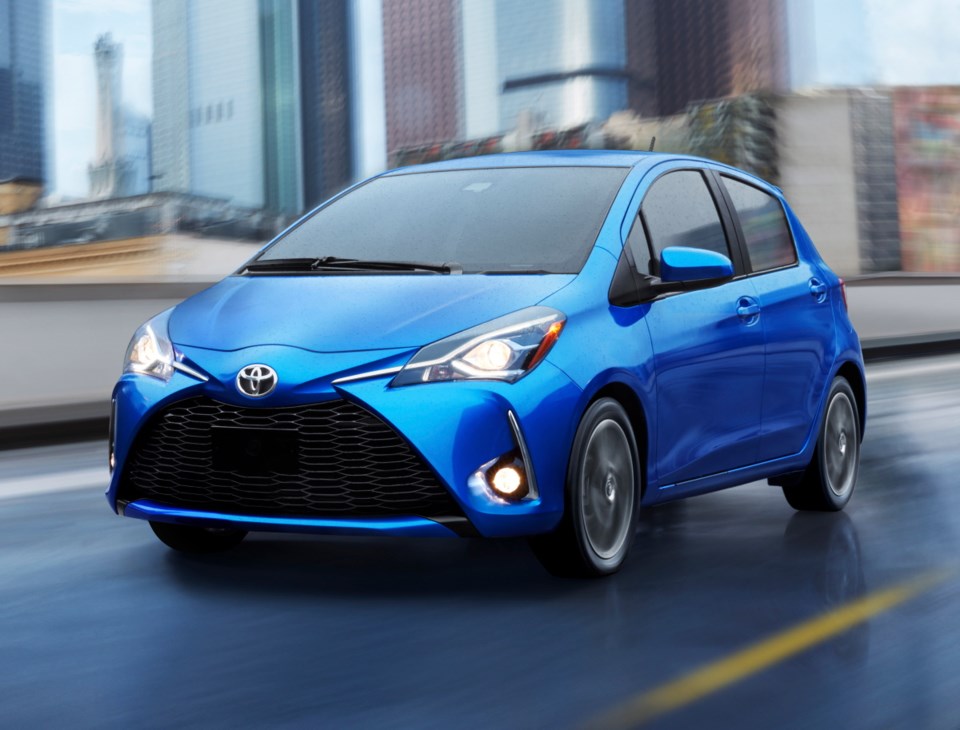You don’t have to spend a lot to get a lot these days, at least when it comes to the Yaris hatchback. What this tiny Toyota mostly delivers is plenty of passenger and stowage space for your money, plus some usually optional safety tech added in for good measure.
The Yaris hatch has been around in its current body style since the 2009 model year, which is, like, forever in the auto industry. The Yaris sedan, however, called the iA, was originally badged a Scion and is supplied by Mazda.
For 2018, the built-in-France Yaris has been given a revised front end that’s really not much different than the previous 2015-model-year nose job. Acknowledging that beauty is in the eye of the beholder, the look can best be described as unique, expressive and unlike any other car on the road.
From the windshield back, the Yaris is your garden-variety hatchback and can be had with two or four passenger doors, which is a choice not offered by competing models. Considering most hatchback buyers are seeking maximum versatility, selecting the two-door version doesn’t seem to make much sense, other than to provide slightly better access to the front seats.
The interior is a relatively roomy environment for five adults, even with three in back, which is uncommon in a small car. The front seats aren’t particularly supportive (you perch upon, rather than sit in), but the control panel is well laid out, the gauges are easy to read and soft-touch material now covers the top of the dashboard. While the steering wheel adjusts up and down, it does not telescope, which three different drivers of the test car independently pointed out as a flaw.
The back seat folds nearly flat, which is atypical of many small hatches (i.e. the Kia Rio5 and Ford Fiesta). That, and a tall body structure result in stowage volume that more than doubles with the rear bench lowered. The Yaris is also quieter and feels more solid than before.
A twist of the key — no pushbutton here — starts the 106-horsepower 1.5-litre four-cylinder engine. Horsepower is unchanged since the very first Yaris, which puts it at the bottom of the class. A curb weight of about 1,045 kilograms (between 90 and 135 kilograms less than competing vehicles) gives the Yaris good low-speed acceleration, however. The car is quite peppy, but there’s more noise than thrust the harder you work the engine.
Toyota has done a superb job with the Yaris’s suspension, especially over rough pavement where there’s hardly any of the harshness you might expect from such a basic model. The only quibble is that the steering starts to feel a bit numb at highway speeds, which is particularly noticeable in crosswinds. Otherwise, the Yaris is really quite fun to drive, sort of like a better-riding Mini Cooper.
Transmission choices include a five-speed manual or available four-speed automatic. It isn’t exactly cutting-edge technology, but fuel economy is decent. The manual is rated at 7.8 l/100 km in the city and 6.5 on the highway, and the automatic is rated at 7.9/6.8.
The base Yaris CE three-door rings in at $17,300, including destination charges ($980 extra for the four-door CE). Both are light on content, but do include heated front seats and a 6.1-inch display screen.
Move up to the LE and you get air conditoning, keyless entry, heated outside mirrors and cruise control.
The SE adds a premium audio system, heated sport bucket seats, front disc brakes, rear spoiler and 16-inch alloy wheels (15-inch steelies are standard).
Note that all Yaris hatchbacks have standard emergency braking, lane-departure alert and automatic high-beam-headlight control as part of Toyota’s Safety Sense technology. A backup camera is also standard, but blind-spot and cross-traffic backup alerts aren’t offered.
The clincher might be a presumed reputation for build quality and high resale value. Both are likely deciding factors for buyers choosing the Yaris over other hatchbacks, regardless of price or content comparatives.



